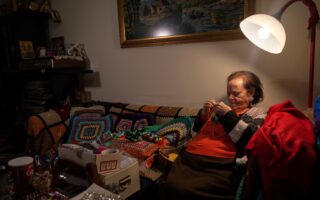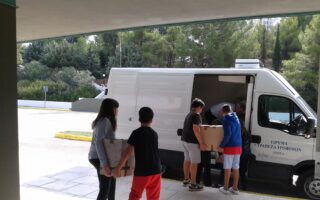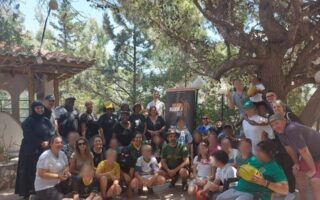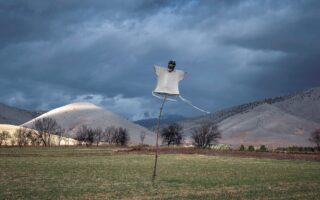The enduring contribution of a late benefactor
Up until 1974, Kyparissi, in Laconia, was cut off from the world. Now, thanks to Antonis Giouzelis, it is an international climbing destination
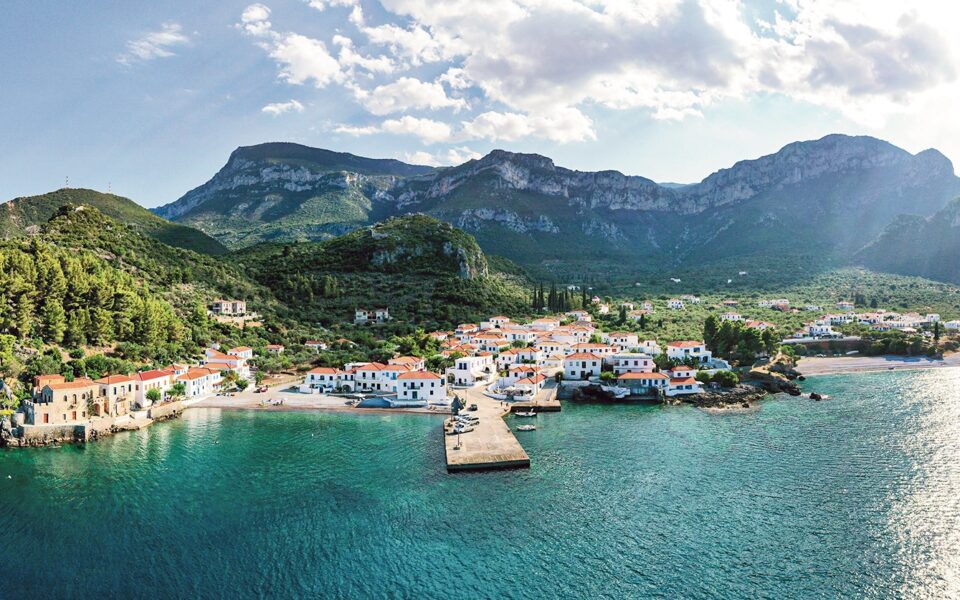
As a boy in the interwar years, Antonis Giouzelis would help his father with the family flock of sheep and goats on the steep mountainsides of Kyparissi in Laconia, in the southeastern Peloponnese. Every so often, he’d ask the time and his father would have to look at the sun to give a rough estimate. A poor man, he had no watch. “When I grow up, I’m going to go to America and make lots of money and buy lots of watches. I’ll even send a clock to the village,” the boy would say. Indeed, the clock tower at the Church of Koimisis tis Theotokou was built in 1951 with money he donated. Antonis Giouzelis kept his promise – and he hasn’t stopped helping his ancestral village since.
 He went to America, to Oakland, California more specifically, and got into the restaurant business, where, as Tony Julius, he amassed a fortune that allowed him to offer economic assistance to Kyparissi every so often. Even after death, he endowed the lion’s share of his fortune to the Tony Julius Fund, which carries on his good work. Thanks to the foundation, which is managed by Myriad USA in cooperation with the Bodossaki Foundation in Greece, his memory and his love for his village live on through a series of initiatives.
He went to America, to Oakland, California more specifically, and got into the restaurant business, where, as Tony Julius, he amassed a fortune that allowed him to offer economic assistance to Kyparissi every so often. Even after death, he endowed the lion’s share of his fortune to the Tony Julius Fund, which carries on his good work. Thanks to the foundation, which is managed by Myriad USA in cooperation with the Bodossaki Foundation in Greece, his memory and his love for his village live on through a series of initiatives.
Isolated
Kyparissi is nestled in a dense forest of olive, carob and cypress trees on Mount Parnonas on the coast of Laconia, looking out to the Myrtoo Sea. It is more than a four-hour drive from Athens and two hours from Sparta, with the last stretch of the road treacherously winding through the craggy landscape. It is no surprise that until 1974, the village could only be reached on foot or by sea.
“Opening the road was an arduous task that began in 1970 with a tractor, a jackhammer and the labor of the local men, whose participation in the project for five days a month was mandatory. With a lot of hard work, it reached the neighboring village of Harakas, but they could not break through the rock without the intervention of the Army Engineering Corps. Even they struggled. It took them four years to get through. The crew came with brand-new machines that were ready for the junk heap by the time it was done,” Konstantinos Gavrilis, the president of the Community of Kyparissi, recalls.
The road may have been opened, but it wasn’t paved until the mid-1990s. “It took the bus three hours on a terrible road littered with boulders to reach Molaoi, the nearest town. We were basically an island, and that’s how our lives had always been organized, taking isolation for granted. Then there was a subsidized ferry connection with Piraeus until it was abolished in 2000. We did everything we could to revive it, but it didn’t happen. The ministry could not understand the extent of our isolation,” says Panagiotis Traiforos, the deputy mayor of Monemvasia Municipality, who is responsible for the municipal unit of Harakas, to which Kyparissi belongs.
Results
Neither official knew Antonis Giouzelis personally, but they do know what he has done for the village of some 270 residents. “His endowment was initially managed by the Metropolitan Bishopric in Sparta. There was no transparency whatsoever. Thankfully for us, the American foundation took legal action when the Church failed to send a financial statement for years. Cooperation with the Bodossaki Foundation since 2011 has been exemplary – and it has brought results,” says Traiforos.
‘I love my village and I love the life here, but the battle for improving the conditions is relentless’
Thanks to an annual inflow of some 20,000 euros a year, a lot has been accomplished in Kyparissi in the past 13 years. The school building – originally constructed in the late 19th century to a design by Ernst Ziller – has been upgraded, as has the health center. The village’s churches, some of which were on the brink of collapse, were repaired. Improvements were made to the playground and the beach was equipped with new benches, an exercise area and a mechanism allowing wheelchair access to the water. Lights were installed along the footpath connecting the village center with the Church of Agios Georgios, a popular walk among locals and visitors, and a soccer field is in the works, while residents in need of assistance were helped, as per the terms of Giouzelis’ will. One of the most impactful projects, however, was the opening of climbing routes, which began in the 1980s. It was an initiative that spurred investments from local private and municipal stakeholders which helped establish Kyparissi as an international climbing destination.
Climbers’ paradise
 “I first visited the area in 2007 to explore its potential. I was impressed by the rocks – solid limestone of the best quality – and the natural beauty. It was March and the village was practically deserted. The tourism season was short, just two months in the summer, and only a handful of villagers, mainly elderly residents, stayed for the rest of the year. I immediately saw that this place could become a climbers’ paradise,” says Aris Theodoropoulos, a mountain guide and mountaineering-climbing instructor who was the first to see the potential of Greece’s mountains as engines of growth, and to transform the island of Kalymnos into a mecca for the sport. “We created some 450 good-quality, safe climbing routes over 12 rock faces in and around Kyparissi and the nearby villages. We organized two small but very successful festivals. They didn’t have much of a budget, but attendance surpassed expectations. We had top climbers among the official guests, including the Austrian world champion Angy Eiter, who fell in love with Kyparissi and became its ‘ambassador’ in the international climbing community. Kyparissi now has tourism almost all year round, the local economy has been boosted, hotels and restaurants stay open, and young people have the option of staying. They don’t have to look for work in Athens or emigrate, as previous generations did,” he adds.
“I first visited the area in 2007 to explore its potential. I was impressed by the rocks – solid limestone of the best quality – and the natural beauty. It was March and the village was practically deserted. The tourism season was short, just two months in the summer, and only a handful of villagers, mainly elderly residents, stayed for the rest of the year. I immediately saw that this place could become a climbers’ paradise,” says Aris Theodoropoulos, a mountain guide and mountaineering-climbing instructor who was the first to see the potential of Greece’s mountains as engines of growth, and to transform the island of Kalymnos into a mecca for the sport. “We created some 450 good-quality, safe climbing routes over 12 rock faces in and around Kyparissi and the nearby villages. We organized two small but very successful festivals. They didn’t have much of a budget, but attendance surpassed expectations. We had top climbers among the official guests, including the Austrian world champion Angy Eiter, who fell in love with Kyparissi and became its ‘ambassador’ in the international climbing community. Kyparissi now has tourism almost all year round, the local economy has been boosted, hotels and restaurants stay open, and young people have the option of staying. They don’t have to look for work in Athens or emigrate, as previous generations did,” he adds.
Problems remain
Nektaria Traiforou confirms the boost that climbing tourism has given Kyparissi. She hails from Ierakas, further south along the eastern Laconian coast, and came to the village as a “love migrant,” having married a local. Her husband’s family were livestock farmers and ran a small taverna, mainly frequented by locals. But he and his brother went on to open a bar catering to the sailing and yachting crowd near the picturesque harbor of Agios Nikolaos. What was a small business went on to grow into a successful restaurant and then into the hotel Cavo Kortia, with 13 studios and apartments.
“It was our dream to build those units. We got funding through the EU’s National Strategic Reference Framework in the 2000s but then stumbled during the crisis, which nearly did us in. The climbers thankfully breathed new life into our village. Before the climbing routes were created, we’d lock up everything in early September and leave. Now we operate all year round. Our children work with us too. Our eldest, Aristeidis, went to Athens and worked as a waiter for a while. You know what they paid him? Just 2.50 euros an hour. He came running back. Who can possibly make ends meet with wages like that? It’s so important to be able to live in your native land,” she tells Kathimerini.
The advent of tourism hasn’t solved all of Kyparissi’s problems, though. “Access is still an issue, there’s no ATM and we don’t have a pharmacy. We all make sure to keep a stock of medications that we can share when needed. We got assigned a rural physician three years ago but he’s not here all the time [as he is also posted to Molaoi] and that gives us a lot of insecurity; not just for us, but for visitors as well. How can we deal with an emergency? Or an accident with a climber? Every time I get a call from a family with young children I first ask the doctor if he’ll be here on the dates they want and then confirm the reservation,” says Traiforou.
“We’re doing what we can to stay in the village and keep it propped up, so it doesn’t fall into ruin, but the state needs to help too, it needs to support rural communities, give us incentives and choices, not just words and promises. We only see the politicians of this regional unit once every four years, before the elections, when they’re fishing for votes. How can we not feel neglected? The only thing that has given us some courage in recent years has been the presence of the Bodossaki Foundation. I wish more of our fellow compatriots followed the example of Antonis Giouzelis. It is truly moving when people who have money use it in such a meaningful way,” adds Traiforou.
School reopens
Matoula Papageorgiou teaches kindergarten and has been in Kyparissi for 10 years now. “The village kindergarten had closed a decade ago, but ever since more opportunities for work opened up, several couples stayed on or returned. Now we have four children in the kindergarten and 10 in the elementary school. The rate of ‘renewal’ is one child a year; next year will be an exception because we’re expecting twins! Our pupils certainly gain something by living in the countryside, but they also miss out on a lot in terms of stimulation and socialization,” she says.

“Despite the efforts being made and however much the donations have helped the village, the challenges are very specific: We are cut off here, and that won’t change,” says Vassiliki Manolopoulou, the elementary school’s teacher. “When I was put up for the job opening here a year ago, my colleagues warned me that I’d be ‘buried’ in Kyparissi. But the community has given me a lot of support and I love the kids. I’m having a good time. But the truth is that there are no extracurricular activities for the children or for teenagers and younger adults. If you want to learn a foreign language (with the exception of English, which is offered here thanks to the Bodossaki Foundation) or do a sport, you need to go to Molaoi. That’s two hours on the bus there and two hours back. We’re trying to fill the gap as best we can. Matoula volunteers to teach traditional Greek dances and I helped create a library, which is our pride and joy,” she adds.
As we leave the school, we run into Stella Vasileiou, a mother bringing her 9-year-old daughter a packed lunch. Her family is in the tourism business, renting rooms. “The village has been doing better lately. Climbing has helped a lot because we have visitors outside the summer season, but it’s still a struggle, especially in the winter. We are far from everything and everything is hard. When my daughter finishes elementary school she will have to go to middle school in Molaoi and stay in the boarding house there. She’ll be just 12 years old. How can she live away from home, away from her parents at that age? I love my village and I love the life here, but the battle for improving the conditions is relentless.”
Organized, transparent donations
 Athina Dessypri is the president of the Bodossaki Foundation, which manages the Tony Julius Fund in Greece. She spoke to Kathimerini about the endowment and the foundation’s plans.
Athina Dessypri is the president of the Bodossaki Foundation, which manages the Tony Julius Fund in Greece. She spoke to Kathimerini about the endowment and the foundation’s plans.
How does the Bodossaki Foundation handle private donations?
Once a private donor expresses interest, we start by prioritizing the goals they wish to support – such as promoting education, improving healthcare, protecting the environment or supporting vulnerable social groups, among others. These are then finalized with the help of our team of experts. They then need to choose whether the donation will be anonymous or in their name, as well as whether it will be used within a specific period of time or, if the amount allows it, will be of an ongoing nature. Based on the patron’s decisions, we put together a detailed proposal with the different charitable initiatives, their anticipated results, potential partners for the execution side of things, a timeline and a supervisory and oversight mechanism. For the next stage – the execution of the program – the foundation relies on the certified management mechanisms it has and activates a wide network of strategic associates from the Greek scientific community, from other foundations and from carefully selected civil society organizations and state agencies.
What do donors usually look for when they’re putting their money in your hands? How is the relationship of trust built?
They usually know about the foundation’s charitable activities and its good name beforehand, so the relationship starts on a footing of trust. This is confirmed when they subsequently verify our strict and impeccable management and control mechanisms, get to know our capable staff, receive detailed briefings, find that the financial statements are audited by an independent firm of certified public accountants and published on our website, and see our dedication to detail and commitment to high standards.
Local communities are usually worried about addressing their immediate needs, whereas you also look to the future. How are the two points of view balanced?
Donations like the Antonis Giouzelis endowment, which secures a steady, annual flow of resources, allow both present and future to be addressed, which is what we did in Kyparissi. We carried out work on the school, the playground and the village churches, but at the same time, we supported the initiative to create climbing routes, which turned Kyparissi into a pole of attraction for climbing tourism from all over the world, transforming the village’s economy.
How are these projects carried out? Are intermediaries involved? And who checks them?
Based on the ISO-certified donation procedures of the foundation, we solicit and evaluate at least three offers for the implementation of each project. In site development programs, we strive to work with businesses and professionals from the area. We monitor the progress of the work, the quality and the outcome of the projects with our partners.
Can there be more endowments like the one for Kyparissi in Greece?
It would be our pleasure to contribute to this end.
Apart from programs for reviving and developing specific places, what sort of program do most donors want to support?
Scholarships that help young people realize their dreams and usually scholarships named after the donor or a loved one.
Are such endowments customary for Greeks? If not, how could that change?
We believe that many fellow Greeks, including diaspora Greeks, want to contribute but don’t know how. They are looking for a vehicle they can trust. The culture changes with this trust and this trust is, in turn, built on rules, on supervision from the state and on self-regulation on the part of civil society. When you are managing money that belongs to your own or some other organization, you need to do so with professionalism, transparency and accountability.
What do you think Antonis Giouzelis would say if he could see his village today?
I don’t know what he’d say, but I hope he’d be moved and proud of what his endowment is offering generations to come in his village, so many years after his own journey away from home.
